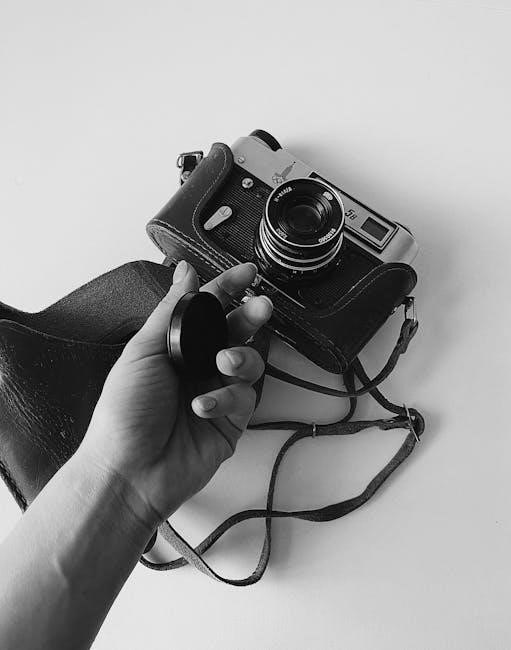
The reverse manual valve body is a high-performance transmission component designed for racing and high-powered vehicles, offering precise manual control and engine braking capabilities in a compact design.
1.1 Definition and Purpose
A reverse manual valve body is a specialized transmission component designed to provide precise manual control over gear shifts in automatic transmissions. It reverses the shift pattern to prevent accidental neutral shifts and enhances engine braking, making it ideal for racing and high-performance applications where driver control and quick, firm shifts are critical.
1.2 Brief Overview of Key Features
The reverse manual valve body features a reversed shift pattern, eliminating accidental neutral shifts, and offers enhanced engine braking with low band apply for sprag protection. Constructed with billet aluminum, hard-anodized surfaces, and CNC-machined components, it ensures durability and precise control, making it suitable for both racing and high-powered street vehicles requiring instantaneous shifts and firm engagement.
Key Features and Components
Featuring billet aluminum construction, military-spec anodizing, and CNC-machined components, the reverse manual valve body ensures durability and precise control, with hardened step washers and a water-jet-cut separator plate for optimal performance and alignment.
2;1 Design and Construction
The reverse manual valve body is crafted from billet aluminum, ensuring exceptional strength and durability. Its design incorporates a CNC-machined structure with a water-jet-cut separator plate and hardened step washers for precise alignment. Military-spec Type 3 hard anodizing prevents bore wear, while the compact, lightweight construction enhances overall transmission efficiency and performance in high-stress environments.
2.2 Functional Aspects of Reverse Pattern
The reverse pattern valve body alters the shift sequence to P-R-N-1-2-3-4, eliminating accidental shifts into neutral during high-RPM operations. This design prevents misshifts, enhances control, and ensures consistent gear engagement. It also enables manual shifting without automatic interference, making it ideal for racing applications where precise driver input is critical for optimal performance and reliability.
2.3 Role of Engine Braking
Engine braking in a reverse manual valve body enhances control during downshifts and deceleration by increasing pressure on the bands or clutches; This feature prevents excessive wear on the braking system and provides smoother transitions between gears, particularly useful in racing and high-performance applications where precise control and stability are critical for maintaining traction and vehicle balance.
2.4 Material and Manufacturing Quality
Reverse manual valve bodies are crafted from high-quality materials like billet aluminum, ensuring durability and resistance to wear. Advanced manufacturing techniques, including CNC machining and water jet cutting, guarantee precision and consistency. Hardened components and military-spec coatings enhance longevity, providing a robust solution for high-performance applications.

Installation and Setup
Installing a reverse manual valve body requires draining the transmission, removing the pan, and carefully replacing the valve body. Special tools and precise alignment are essential. Common mistakes include improper installation of the separator plate and failure to engage the manual valve correctly, which can lead to transmission malfunctions.
3.1 Step-by-Step Installation Guide
- Drain the transmission fluid and remove the transmission pan to access the valve body.
- Disconnect the shift linkage and carefully remove the old valve body, taking note of its position.
- Install the new reverse manual valve body, ensuring proper alignment with the separator plate.
- Reattach the shift linkage and secure the valve body using stock-length bolts.
- Replace the transmission pan and refill with the recommended fluid.
- Test the transmission by manually shifting through all gears to ensure proper engagement.
3.2 Special Tools and Requirements
Installing a reverse manual valve body requires specific tools, including a transmission pan gasket, separator plate, and alignment tools. Ensure compatible transmission fluid and a high-stall converter for optimal performance. A professional mechanic or experienced technician with knowledge of manual transmissions is highly recommended for proper installation and setup.
3.3 Common Mistakes to Avoid
Common mistakes include improper alignment of the manual valve with the shift linkage, insufficient tightening of valve body bolts, and failure to replace worn components like gaskets and seals. Additionally, not following the manufacturer’s torque specifications or using incorrect transmission fluid can lead to performance issues and potential damage to the valve body.
Advantages of Reverse Manual Valve Body
The reverse manual valve body offers enhanced engine braking, precise manual control, and improved shift accuracy, making it ideal for racing and high-performance applications, ensuring optimal driver command and reliability.
4.1 Enhanced Performance
The reverse manual valve body delivers superior performance through instantaneous shifts and engine braking capability, eliminating delays associated with automatic shifting. Its design ensures precise control, especially in high-stress racing environments, while maintaining reliability under extreme conditions. This makes it a preferred choice for drivers seeking direct command over gear transitions and optimal power delivery in high-performance vehicles.
4.2 Improved Control and Precision
The reverse manual valve body offers exceptional control, allowing drivers to manually regulate gear shifts without relying on automatic systems. This precision enhances responsiveness, particularly during aggressive driving or racing, enabling smoother and faster transitions. The design minimizes mechanical lag, ensuring each shift is immediate and deliberate, which is critical for achieving optimal performance in high-stakes environments.
4.3 Suitability for Racing and High-Powered Vehicles
The reverse manual valve body is ideal for racing and high-powered vehicles due to its robust design and precise control. It eliminates automatic shifting delays, providing instantaneous gear changes essential for competitive racing. Engine braking in first gear adds stability, making it a preferred choice for drivers seeking peak performance and reliability in demanding conditions.
4.4 Benefits of Engine Braking in Gear Control
Engine braking in the reverse manual valve body enhances gear control by providing stable speed reduction during downshifts. This reduces wear on brakes and improves control, especially in performance driving. The system integrates seamlessly with the valve body’s design, offering precise modulation and preventing unwanted wheel lockup, thus optimizing overall vehicle stability and driver confidence.
Applications and Compatibility
The reverse manual valve body is ideal for racing and high-performance vehicles, compatible with transmissions like TH400, 4L80E, and 4L85E, offering superior control in both street and track settings.
5.1 Popular Transmission Models
Reverse manual valve bodies are commonly used in high-performance transmissions like the TH400, 4L80E, 4L85E, and 48RE. They are highly compatible with Chevrolet and Ford applications, offering enhanced control for racing and street performance vehicles, ensuring precise shifting and reliability in demanding conditions.
5.2 Racing and Street Performance Use Cases
Reverse manual valve bodies excel in both racing and street performance, providing instantaneous shifts and engine braking control. They are ideal for drag racing, off-road rigs, and high-powered street cars, delivering firm, positive engagements. Their design minimizes wear and enhances driver control, making them a preferred choice for demanding applications requiring precision and reliability.

Troubleshooting and Common Issues
Common issues include gear engagement problems, leaks, and neutral engagement difficulties. Proper adjustment of the manual valve and servo ensures smooth operation and prevents pressure loss.
6.1 Diagnosing Gear Engagement Problems
Gear engagement issues often manifest as slipping, hesitation, or failure to shift. Inspect the manual valve, servo, and accumulator for wear or misalignment. Check hydraulic pressure and fluid levels, as low pressure can cause incomplete engagements. Ensure the shift linkage is properly aligned and adjusted. Worn or damaged components may require replacement to restore proper function.
6.2 Addressing Leaks and Pressure Loss
Leaks and pressure loss in a reverse manual valve body often stem from damaged seals or gaskets. Inspect the hydraulic system for cracks or wear. Replace any compromised components and ensure proper alignment of the valve body. Clean or replace clogged hydraulic lines and verify the pump’s functionality to restore optimal pressure and prevent fluid leakage.
6.3 Solving Neutral Engagement Difficulties
Neutral engagement issues often arise from improper manual valve adjustment or misalignment with the shift linkage. Ensure the valve is correctly calibrated and the linkage is securely connected. Check for worn or damaged components like the neutral switch or shift forks, and replace them if necessary to restore smooth neutral engagement and prevent transmission misalignment.
Maintenance and Repair
Regular maintenance involves inspecting valve body components, cleaning debris, and replacing worn parts. Use high-quality transmission fluid and ensure proper alignment during reassembly to maintain optimal performance and longevity.
7.1 Best Practices for Longevity
To ensure longevity, flush the transmission system with a high-quality solvent and replace worn components promptly. Use military-spec hard anodized parts to prevent bore wear. Regularly inspect and clean the valve body, separator plate, and gaskets. Lubricate moving parts with recommended transmission fluid, and align components precisely during reassembly to maintain smooth operation and prevent damage. This maintenance routine helps extend the life of the reverse manual valve body, ensuring consistent performance in both racing and high-powered street applications.
7.2 Rebuilding and Refurbishment
Rebuilding involves disassembling the valve body, inspecting for wear, and replacing components like check balls and springs. The separator plate is water jet cut for precision, while valve body halves are CNC-machined. Hardened step washers and military-spec anodizing prevent damage. After refurbishment, components are recalibrated to ensure smooth shifts and optimal performance, extending the valve body’s service life effectively.
Future Trends and Innovations
Future innovations focus on integrating advanced materials and CNC machining for improved durability. Billet designs and precise engineering enhance performance, ensuring reliability in high-stress environments like racing.
8.1 Technological Advancements
Advancements include CNC-machined billet valve bodies for precision and durability. Integration of hardened components and anodized finishes prevents wear. Modern designs optimize shift timing and engine braking, enhancing control. These innovations cater to high-performance applications, ensuring reliability and consistent gear engagement in demanding racing and street environments.
8.2 Integration with Modern Transmission Systems
Modern reverse manual valve bodies are designed for seamless integration with updated transmission systems, offering direct replacements for models like the 4L80E. They often require no shift computer, making them compatible with both electronic and mechanical setups. These designs ensure optimal performance in contemporary vehicles, maintaining reliability while enhancing driver control and responsiveness in high-demand scenarios.

Comparison with Forward Pattern Valve Bodies
Reverse manual valve bodies differ from forward pattern valve bodies in their shift sequence, offering improved control and performance for racing applications, with engine braking in lower gears.
9.1 Shift Patterns and Driver Experience
Reverse manual valve bodies feature a shift pattern of P-R-N-1-2-3-4, preventing accidental shifts into neutral during high RPM. This design enhances driver control, especially in racing, by eliminating unintended gear changes. The reverse pattern also provides a more intuitive shifting experience, particularly for drivers accustomed to manual transmissions, while maintaining precise control over gear engagement and disengagement.
9.2 Performance and Control Differences
Reverse manual valve bodies deliver superior performance and control compared to forward patterns. They eliminate automatic shifting, allowing drivers to maintain full control over gear changes. Enhanced engine braking in lower gears improves stability, especially during aggressive driving. This setup is ideal for racing, where precise control and quick shifting are critical for optimal performance and reliability.

Case Studies and Real-World Examples
The reverse manual valve body is widely used in racing, such as the Turbo 400 and 4L80E, and in high-performance street vehicles, offering improved control and performance.
10.1 Successful Implementations in Racing
In racing applications, the reverse manual valve body has proven its effectiveness. For instance, in drag racing, it allows precise gear control, enhancing acceleration and reducing shift times; The TH400 and 4L80E models are popular choices among racers, offering firm shifts and improved engine braking. This component is critical for maintaining competitive performance at high speeds.
10.2 Street Performance Applications
The reverse manual valve body excels in street performance, offering precise control and firm shifts. Compatible with high-stall converters, it enhances acceleration and responsiveness; Drivers appreciate its ease of use on the street, making it a versatile upgrade for performance vehicles. Its direct replacement design ensures compatibility with popular models like the 4L80E and TH400, ideal for street-driven cars.
The reverse manual valve body enhances performance, control, and engine braking, making it ideal for racing and high-powered vehicles. Its design offers precise shifts and versatility for street use, providing a reliable and efficient solution for drivers seeking enhanced transmission control and responsiveness in demanding driving conditions.
11.1 Final Thoughts
The reverse manual valve body offers exceptional performance, precision, and control, making it a top choice for racing and high-powered vehicles; Its robust design, engine braking capabilities, and versatility for both street and track use ensure reliable operation. For drivers seeking enhanced transmission control, this component is a valuable upgrade, delivering consistent and responsive shifting in demanding conditions.
11.2 Recommendations for Potential Users
For optimal performance, pair the reverse manual valve body with a high-stall converter and a precise shifter. Regular maintenance and professional installation are crucial to ensure longevity and reliability. Drivers transitioning from automatic to manual control should practice shifting techniques to maximize the benefits of this setup, especially in competitive racing environments. Proper adjustment and tuning are essential for seamless operation.